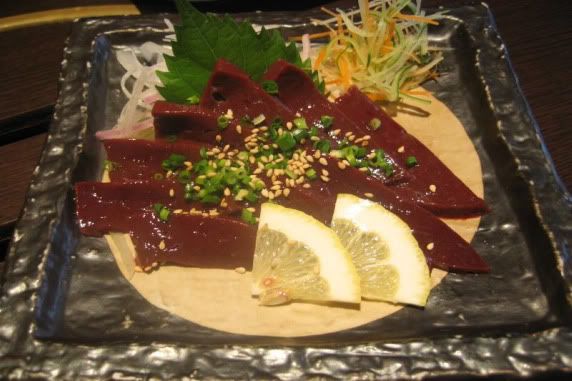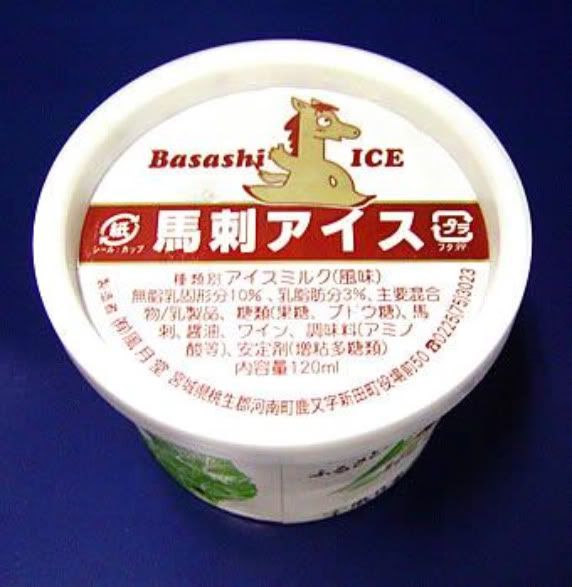
1. South Korea: Bosintang Soup (Dog)
Dog meat is the main ingredient in South Korea’s highly prized Bosintang soup. The dish, which costs around 10 USD, is made from boiled dog bits (lean dogs are considered the most tasty) mixed with spices like green onions, Taro stalk, leeks, ginger, garlic, and perilla, an herb in the mint family that helps disguise the intense smell of cooked dog.
Although Bosintang isn’t necessarily known for its culinary appeal (the meat has been described as having a flaky, gamey dark beef flavor) it is famous for its medicinal value for improving male virility and cooling the body (and centering one’s “ki” during sweltering summer months). Even though the consumption of dog meat has been outlawed in South Korea since 1984, many traditional restaurants throughout the country still serve up this dish.

2. Japan: Basashi (Horse)
Japan is known for some adventurous cuisine, and Basashi is no exception. The dish consists of horse (ba) served raw like sashimi (sashi) with a simple soy dipping sauce on the side. Served around Japan in izakayas (local bars that serve finger food), basashi can be found all over the country, although the cities of Matsumoto and Kumamato are known for some of the best horse meat in the country.
With a texture that’s described as sweet, smooth, and creamy, it doesn’t seem to be too much of a stretch to turn the delicacy of Basashi into…ice cream! Multiple Japanese companies have their own version of basashi ice cream that are sold with chunks of meat frozen in the carton.
4. Cambodia: Fried Tarantulas
Although these little guys are fried up all over Cambodia, the Sukon Market is known for serving the tastiest fried Tarantulas and have developed a bit of a cult following – tourists and locals come to Sukon specifically to get their fix. The type of tarantula used for this snack is called a-ping and they are a palm-sized variety that are locally caught by the street vendors who sell them by the hundreds for around 8 cents USD.

To prepare them, the tarantulas are pan fried whole, with their legs and fangs still attached, with only a pinch of garlic and salt for flavor. Even though their preparation is relatively simple, people rave they have a great natural flavor and that their consistency, crunchy on the outside and gooey on the inside, is particularly unique and delicious.

5. Philippines: Balut (Duck)
Although Balut is served all over Asia, the Philippines are best known for this snack of boiled, fertlized duck eggs. Balut is prepared by boiling the fertilized eggs around 15 days after they are laid, just a few days before the embryo is ready to hatch. The eggs are then stored in buckets of sand to maintain their heat and are served warm. They are particularly popular as a drinking snack in night markets around Cambodia, not only because some people find them delicious, but because they are said to be a powerful aphrodisiac and improve virility in men.

6. Nicaragua: Green Iguana Soup
Green Iguanas are eaten year round throughout Central and South America, but they’re are especially popular during Holy Week (the week before Lent begins) in Nicaragua. Unfortunately, Green Iguana females ovulate right around April, and so during Holy Week the iguanas are swollen with eggs, making the consumption of them during that time period particularly disastrous for the Iguana population.

For this reason the Nicaraguan government has banned the killing of Green Iguanas, although the traditional preparation of the iguanas into a soupy dish called Indio Viejo, persists.

7. Germany: Hasenpfeffer (Rabbit)
The traditional German dish of Hasenpfeffer consists of a rich rabbit stew made from soaking the rabbits in juices and letting the mixture sit for two to three days. In the traditional preparation of the dish, the last ingredient a cook would add before the soup was served was a few cups of rabbit blood. This last ingredient, which is usually omitted in modern preparations of the dish, was used to thicken the soup to the proper consistency. Proper care and attention to detail was needed however; if the blood was added while the soup was still too hot, the blood will curdle, ruining the soup.

No comments:
Post a Comment